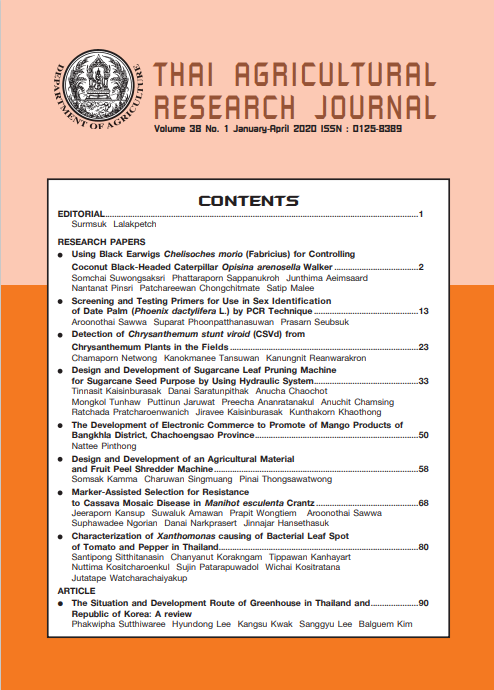Characterization of Xanthomonas causing of Bacterial Leaf Spot of Tomato and Pepper in Thailand
DOI:
https://doi.org/10.14456/thaidoa-agres.2020.7Keywords:
Xanthomonas, bacterial leaf spot disease, tomato, pepper, multilocus sequence, housekeeping genesAbstract
Bacterial leaf spot disease of tomato and pepper is the importance disease in Thailand especially to seed exporting industry. Xanthomonas spp. associated with bacterial leaf spot disease of tomato and pepper were reclassified into four species, namely X. euvesicatoria, X. gardneri, X. perforans, and X. vesicatoria, according to Jones et al., (2004). To assess and update the bacterial pathogens of tomato leaf spot disease of tomato and pepper, 38 bacterial isolates associated with leaf spot disease collected from north, north-east and central part of Thailand which identified as Xanthomonas spp. base on general characteristics of morphology, physiological and biochemical properties, were characterized. Eighteen isolates are selected for further determination by multilocus sequence analysis (MLSA) of gyrB, efp, dnaK and atpD genes and PCR amplification using species-specific primer sets. Based on the characterized results, two species were identified, most of tomato isolates were X. perforans and the others, 10 isolates from pepper as X. euvesicatoria. No X. gardneri and X. vesicatoria were found in this study. However, no PCR products were obtained from all isolates which identified as X. perforans by using the species-specific primer pair Bs-XpF/ Bs-XpR for X. perforans.
References
บงกชไพร ศรีวิไล. 2537. การจำแนกและตรวจสอบเชื้อแบคทีเรีย Xanthomonas campestris pv. vesicatoria (Doidge) Dye ที่เป็นสาเหตุโรคใบจุดของมะเขือเทศ (รายงานผลงานวิจัย). มหาวิทยาลัยขอนแก่น, ขอนแก่น.
วัลลา ดิฐพงษ์พิชญ์. 2539. การวิเคราะห์ plamid และการจำแนก races ของ Xanthomonas campestris pv. vesicatoria. คณะเกษตรศาสตร์ มหาวิทยาลัยขอนแก่น.
วิชัย โฆสิตรัตน. 2549. โรคพืชที่เกิดจากแบคทีเรีย: บทปฏิบัติการ. พิมพ์ครั้งที่ 2. ภาควิชาโรคพืช คณะเกษตร กำแพงแสน มหาวิทยาลัยเกษตรศาสตร์ วิทยาเขตกำแพงแสน, นครปฐม.
Araújo, E. R., J.R. Costa, M. A. S.V. Ferreira and A. M. Quezado-Duval. 2017. Widespread distribution of Xanthomonas perforans and limited presence of X. gardneri in Brazil. Plant Pathology 66: 139-168.
Burlakoti, R. R., C. F. Hsu, J.R. Chen and J. F. Wang. 2018. Population dynamics of xanthomonads associated with bacterial spot of tomato and pepper during 27 years across Taiwan. Plant Disease 102: 1348-1356.
Doidge, E. M. 1921. A tomato canker. Annals of Applied Biology 7(4): 407-430.
Dye D. 1966. Cultural and biochemical reaction of additional Xanthomonas species. New Zealand Journal of Forestry Science 9: 913–919.
EPPO. 2013. PM 7/110 (1) Xanthomonas spp. (Xanthomonas euvesicatoria, Xanthomonas gardneri, Xanthomonas perforans, Xanthomonas vesicatoria) causing bacterial spot of tomato and sweet pepper. EPPO Bulletin 43: 7-20.
Hamza, A. A., I. Robène-Soustrade, E. Jouen, L.Gagnevin, P. Lefeuvre, F. Chiroleu and O. Pruvost. 2010. Genetic and pathological diversity among Xanthomonas strains responsible for bacterial spot on tomato and pepper in the southwest Indian Ocean region. Plant Disease 94: 993-999.
Huelsenbeck, J. P. and F. Ronquist. 2001. MRBAYES: Bayesian inference of phylogeny. Bioinformatics 17:754-755.
Jones, J. B., G. H. Lacy, H. Bouzar, R. E. Stall and N. W. Schaad. 2004. Reclassification of the xanthomonads associated with bacterial spot disease of tomato and pepper. Systematic and Applied Microbiology 27(6): 755-762.
Koenraadt, H., B. Van Betteray, R. Germain, G. Hiddink, J. B. Jones, J. Oosterhof, A. Rijlaarsdam, P. Roorda and B. Woudt. 2009. Development of specific primers for the molecular detection of bacterial spot of pepper and tomato. Acta Horticulturae 808: 99-102.
Rambaut, A. 2018. FigTree v1.4.4. http://tree.bio.ed.ac.uk/software/figtree.
Roach, R., R. Mann, C. G. Gambley, R. G. Shivas, and B. Rodoni. 2018. Identification of Xanthomonas species associated with bacterial leaf spot of tomato, capsicum and chilli crops in eastern Australia. European Journal of Plant Pathology 150(3): 595-608.
Schaad, N. W., J. B. Jones and W. Chun. 2001. Laboratory Guide for Identification of Plant Pathogenic Bacteria (3rd Ed.). APS Press, Minnesota. 398p.
Stall, R. E., C. Beaulieu, D. Egel, N. C. Hodge, R. P. Leite, G. V. Minsavage, H. Bouzar, J. B. Jones and A. A. Benedict. 1994. Two genetically diverse groups of strains are included in Xanthomonas campestris pv. vesicatoria. International Journal of Systematic and Evolutionary Microbiology 44(1): 47-53
Sutic, D. 1957. Bakterioze crvenog patlidzana (Tomato Bacteriosis). Posebna Izdanja Institut za zastitu bilja Beograd (Special Edition Institute for Plant Protection Belgrade), 66p.
Vauterin, L., B. Hoste, K. Kersters and J. Swings. 1995. Reclassification of Xanthomonas. International Journal of Systematic and Evolutionary Microbiology 45(3): 472-489.
Downloads
Published
How to Cite
Issue
Section
License
Thai Agricultural Research Journal



